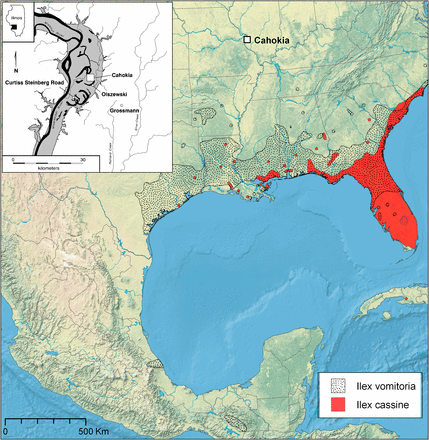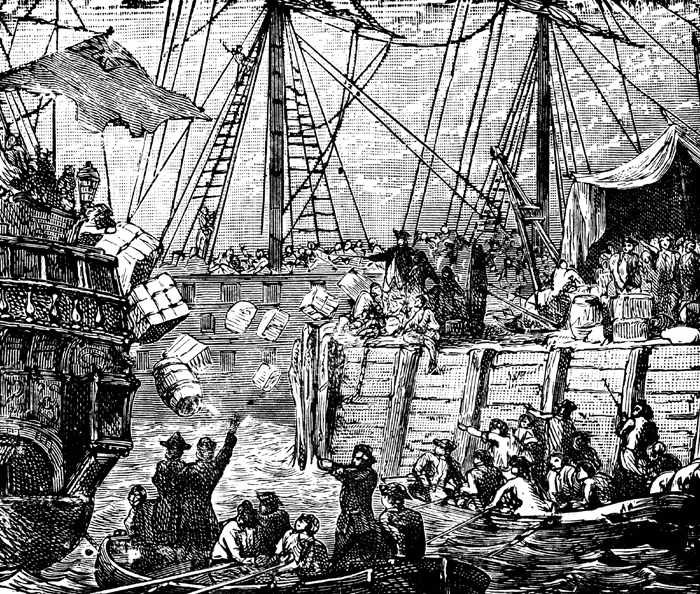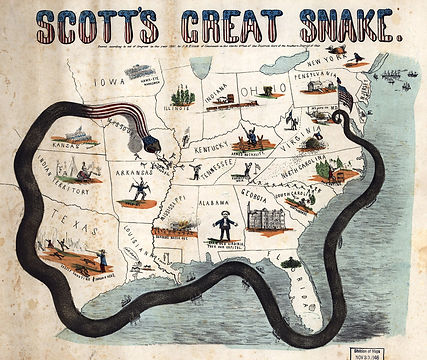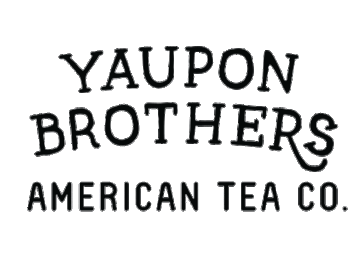

The Intriguing History of Yaupon Holly
And how it's wide-spread usage was almost completely forgotten...
Scroll Down
The history, heritage, and impact of Yaupon Holly (Ilex vomitoria) is as mysterious and intriguing as its origins...
The name Yaupon comes from the Catawba word meaning "The little tree"
Yaupon Holly, a.k.a. the infamous “black drink,” also called Asi, Apalachicola, Cassine, and Cassina tea was a widely consumed beverage throughout colonial North America, with its roots going back thousands of years in Native American tradition. The usage of Yaupon Holly as a drinkable tea was widespread and popular in North America up until the 1800’s, where high demand and low cost for foreign sources of caffeine like coffee and traditional Chinese tea caused Yaupon Holly consumption to almost completely vanish.
Pre-Colonial Period

"Eastern Timucua Indians taking black drink. The shell cups in the pictures are incorrectly showns as nautilus snails rather than conch shells." As stated by the author (Hudson, 1979; Florida Center for Instructional Technology, 2020).
This depiction details the Native American ritual involving the famous black drink, with the consumption of this tincture of various plants and herbs said to cleanse an individual before causing them to vomit.
This ritual is where Yaupon Holly (Ilex vomitoria) gets its name, although it was just one of the various plants in the mysterious black drink

This old map shows the known range of Yaupon Holly (Ilex vomitoria) throughout the southeastern US (Hudson, 1979).
The original usage and discovery of Yaupon Holly is credited to the Native Americans of the southeastern US, who for thousands of years have brewed and consumed Yaupon Holly for ceremonial, ritualistic, and casual settings.
This was done either in the form of the black drink, which was usually a combination of Yaupon Holly and other unknown herbs, or in the form of white tea, which was a much milder form of beverage made from just the leaves and twigs of Yaupon Holly.
This white tea was often drank before public gatherings or even just as a daily morning beverage (Hale, 1891; U.S. Dept of Agriculture, 2943; Hudson, 1979).

(Hudson, 1979)
The consumption of black drink by Native American tribes for various ceremonies, public gatherings, and many other functions was commonplace throughout the southeastern US, with this map showing the likelihood of the many different tribes that consumed the sacred black drink.
The usage of this drink was widespread with Native Americans Tribes, including the Atakapa, Apalachee, Apalachicola, Choctaw, Timucua, Muskogee, Catawba, Cherokee, Algonquins, and Creek Confederacy.
The Cherokee Indians are known to have called Yaupon "the beloved tree."
The Cherokee Indians even cultivated Yaupon Holly hundreds of miles inland for daily use, which can be seen and described in more detail at the Cherokee Heritage Center in Oklahoma.


"Beakers from Greater Cahokia and the hinterlands" dating crica A.D. 1050-1250 (Crown et al., 2012).
Organic residue analysis of ceramics from Cahokia, the largest prehispanic site north of Mexico, shows the presence of theobromine, caffeine, and ursolic acid, biomarkers for Ilex, or the holly genus. Here the researchers provide unique evidence of prehispanic use of Ilex, showing evidence for the continued historical use of caffeinated drinks in ritual activity in North America (Crown et al., 2012; King et al., 2018).
One priest from the 1600’s described Yaupon tea as a necessity for all Spaniards in the America’s as well as back home in Spain:
“There is no Spaniard or Indian who does not drink it every day in the morning and evening...it is more of a vice than chocolate in New Spain [...] any day that a Spaniard does not drink it, he feels that he is going to die," wrote Father Francisco Ximenez in a 1615 text quoting Francisco Hernández de Toledo, a court physician ordered by King Philip II of Spain to study medicinal plants of the New World (Hudson, 1979; History of Yaupon, 2020).
_HR.jpg)

(History of Yaupon, 2020)
Welk shells (left) and carvings shown here have been found at Native American dig sites thousands of years old, with the Eagle man (right) adorned with perforated shells hanging from his necklace.
In many coastal tribes, welk shells were used for tea drinking, with many artifacts since found throughout coastal Native American communities in the southeastern US (Crown et al., 2012).

(Hudson, 1979)
This image captures the true social significance of the black drink and Yaupon Holly consumption, with a Timucuan chief being buried with his tea drinking shell. This burial practice became much more commonplace with Native American cultures around 1,500 years ago, with it bringing the firsts signs of social stratification in Native American cultures.
Burial mounds adorned with tea drinking artifacts like the one depicted above can found throughout much of the U.S., with the origins potentially tracing back to the Manasota people found at Weedon Island, Florida. While their culture and speicifc way of life is unknown, we know they inhabited coastal communities in and around central western Florida, southern Alabama and Georgia for thousands of years before Spanish explorers arrived in the 1500's (Pinellas County Dept of Environmental Management, 1999).
Colonial Period
Moving forward into colonial times, the usage of Yaupon Holly was becoming more and more widespread, with names like Carolina Tea, South Seas Tea, Cassina, Appalachine, and Indian Chocolate showing up in markets across Europe. Early settlers exported literally tons of Yaupon tea throughout the mid 18th century, before its mysterious disappearance in the global marketplace by the mid 19th century (Hudson, 1979).
One theory as to why this popular beverage all but vanished globally has to do with England and the Dutch East India Company. William Aiton, the royal botanist to King George III, was returning on his trip from America when he gave Yaupon Holly (Ilex vomitoria) its unpleasant latin name, right around the turn of the 18th century. It is thought he may have given it such a name due to his connection to the infamous Dutch East India Co., who at the time controlled almost all the global tea market and was in fear of loosing profits (History of Yaupon, 2020).
Many might remember that the United States was formed partially because of unfair taxation on tea by the British, with the Boston Tea Party solidifying public opinion on Britian's role in America at the time.
What many might not know is that right after the Boston Tea Party event, Yaupon tea was sent to Boston under the name "Liberty Tea" to replenish the exported tea! This tea has been an integral part of our countries history, even before our nation was created (About Yaupon, 2020).

The Boston Tea Party (Gowdy, 2013)
Post-Colonial Period
Charles M. Hudson, author of "Black Drink A Native American Tea" summaries the historical fall of Yaupon tea consumption:
Hudson explains how the demise of Yaupon was likely from economic pressures of tea and coffee merchants. Many poor and working class folks who could not afford foreign tea or coffee would drink Yaupon, making it a lower class drink.
During the Civil War there was a temporary spike in Yaupon usage in the south. This was because of the Union Blockade, in which the south was cut of from its foreign sources of caffeine. Shortly after the war, coffee and tea once again became available and solidified their cultural relevance and usage.
There was a temporary resurgence of interest in the early 20th century due the international state of affairs as well as the former Bureau of Chemistry’s studies, in which they investigated the possibility of large-scale Yaupon cultivation. Apart from being a reliable local source of caffeine, they found it to be less labor intensive and equally as cost-efficient as coffee production. As such, 7000 lbs of dry Yaupon was cultivated and sold in local markets and over 30 gallons of hot Yaupon was sold every day of the 1922 Charleston South Carolina County fair (U.S. Dept of Agriculture, 1943).
The idea of large scale Yaupon cultivation in the US even made it to the federal level, as it was discussed and recorded in the Agricultural Appropriations Bill of 1924. In this, the studies conducted by the now former Bureau of Chemistry were mentioned along with the interest and sales at and around the Charleston County Fair. Unfortunately, production never continued beyond this, and Yaupon consumption seemingly all but vanished.
Rumor had it Yaupon Tea was still being sold in the Outer Banks on the small island of Ocracoke, NC up until at least the 1970's. After further investigation, that in fact turned out to be the case.
On the back it reads:
"Yaupon is rich in antioxidants, and it is the only native North American plant containing caffeine. It is claimed to be a tonic, an aphrodisiac, & a cure for hangovers."
Email or call the Village Craftsmen at info@villagecraftmen.com or (252) 928 - 5541
for ordering details
Well there ya have it:
The curious, confusing, and downright strange history of the wonderful Yaupon Holly, North America's forgotten source of local caffeine



Modern day
(Union Blockade, 2020)
(Hale, 1891)
(U.S. Dept of Agriculture, 1943)

(Photo by Phillip Howard)
Luckily since 2012 there are a handful of companies that now sell Yaupon Holly tea, promoting the sale of local, eco-friendly, sustainable products (available online below)
5) Village Craftsmen on Ocracoke Island




